The constellation Cassiopeia has long been known by its popular nickname, the W constellation. Its five brightest stars form the distinctive shape of a W in the northern night sky. The W-shaped asterism is the most visible part of Cassiopeia’s constellation figure, which represents the Greek mythical queen bound to her throne.
Cassiopeia is one of the 48 constellations catalogued by the Greek astronomer Ptolemy in the 2nd century CE. In Greek mythology, Cassiopeia was the queen of Aethiopia and wife of King Cepheus. She was placed in the sky after offending the sea god Poseidon by boasting that she was more beautiful than the Nereids (sea nymphs). As punishment, Poseidon sent a sea monster, represented by the constellation Cetus, to ravage the land and asked that Cassiopeia’s daughter Andromeda be bound to a rock and left for Cetus. Andromeda was saved by the hero Perseus and, as punishment for her vanity, Cassiopeia was placed among the stars and forced to circle the north celestial pole on her throne, spending half of the time upside down.
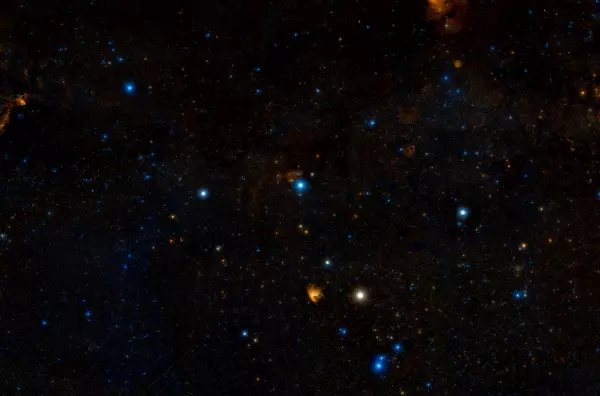
Cassiopeia’s W, image: Wikisky
Cassiopeia is located in a region of the sky full of bright, large nebulae and open star clusters that make easy targets for small telescopes. The Heart and Soul Nebulae, the Double Cluster, the Pacman Nebula, the Bubble Nebula, and the open clusters Messier 52 and Messier 103 are among the many deep sky objects that lie in this area. The W asterism makes it very easy to find these on a clear night.
Cassiopeia’s W is formed by five bright stars at different evolutionary stages, located at different distances. In the order of brightness, these are Schedar (Alpha Cassiopeiae), Caph (Beta Cassiopeiae), Gamma Cassiopeiae, Ruchbah (Delta Cassiopeiae), and Segin (Epsilon Cassiopeiae). Depending on the time of night, the stars may appear as a bright W or M in the sky.
The stars themselves are quite interesting. Even though all five of them are considerably younger than the Sun, four (all except Segin) have already evolved away from the main sequence and entered the final stages of their life cycles. These four stars appear similar in brightness, with apparent magnitudes ranging from 2.24 to 2.68, while Segin is noticeably fainter at magnitude 3.35. All five stars are slightly variable.
Stars
The stars that form the W asterism may appear similar in brightness, but are in fact very different from each other. The oldest in the celestial quintet is Caph (Beta Cassiopeiae), a white giant with an estimated age between 1.09 and 1.18 billion years, and the youngest is Gamma Cassiopeiae, which is only 8 million years old. Even though it is the youngest of the five stars, Gamma Cassiopeiae has already come to the end of its main sequence lifetime. It is classified as a subgiant of the spectral type B0.5IVe.
Caph is also the smallest, least massive and luminous, and nearest of the five stars, lying 54.7 light years away. The most distant star in the W is Gamma Cassiopeiae, located 550 light years away. Gamma is also the most massive and luminous in the group, with a mass 17 times that of the Sun and a luminosity of 34,000 Suns. Schedar is the largest, with a radius 45.39 times solar.
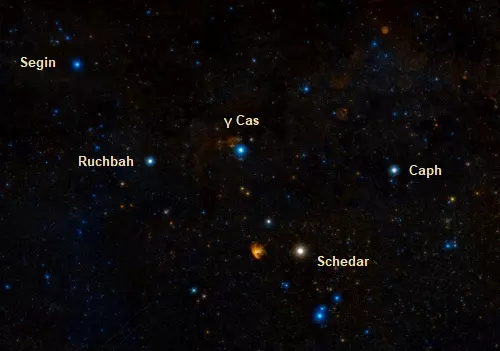
The five stars of Cassiopeia’s W, image: Wikisky
Schedar (Alpha Cassiopeiae)
Schedar, the brightest star in Cassiopeia, is classified as an orange giant of the spectral type K0 IIIa. It shines at magnitude 2.24 from a distance of 228 light years. It has a mass 3.98 times that of the Sun and has expanded to a size of 45.39 solar radii as it evolved away from the main sequence. It is 794 times more luminous than the Sun with a surface temperature of 4,552 K. It has an estimated age of 220 million years.
The name Schedar comes from the Arabic şadr, meaning “chest.” It refers to the star’s position in Cassiopeia, marking the queen’s heart.
Schedar is sometimes listed as a suspected variable even though it has not been observed to vary in brightness since the 19th century.
Caph (Beta Cassiopeiae)
Caph is a white giant star with the stellar classification F2 III. It has an apparent magnitude of 2.28 and lies 54.7 light years away. To the unaided eye, it appears just as bright as Schedar. The star has a mass of 1.9 solar masses and a radius between 3.43 and 3.69 solar radii. With an effective temperature of 7,079 K, it is 27.3 times more luminous than the Sun.
Caph is classified as a Delta Scuti variable, a pulsating star whose brightness varies as it expands and contracts.
Gamma Cassiopeiae
Gamma Cassiopeiae is a prototype for its own class of variable stars, the Gamma Cassiopeiae variables. These are fast-spinning eruptive variables that show irregular variations in brightness over periods of decades. Gamma Cassiopeiae itself varies between magnitudes 1.6 and 3.0. At its brightest, it outshines Schedar to become Cassiopeia’s brightest star.
The star is an exceptionally fast spinner, with a projected rotational velocity of 432 km/s. Due to its high spin rate, it has an oblate shape with a pronounced equatorial bulge. Combined with the star’s high energy output, the fast rotation results in the ejection of material from the star. The expelled matter forms a circumstellar disk of gas and intermittent shell episodes cause the star’s brightness to vary. Pleione in the Pleiades cluster in Taurus and Gomeisa in Canis Minor also belong to this group of variables.
Gamma Cassiopeiae has a mass 17 times that of the Sun, which seals its ultimate fate as a supernova down the line. As it evolved away from the main sequence, the star has grown to a size of 10 solar radii. With a surface temperature of 25,000 K, it shines with 34,000 solar luminosities. Even though it is only 8 million years old, it has evolved quickly due to its high mass and does not have much time left.
Gamma Cassiopeiae is the only one of the five stars of the W that does not have a proper name approved by the International Astronomical Union (IAU). It is sometimes called Navi (Ivan backwards), in honour of the American astronaut Virgil Ivan “Gus” Grissom, a member of the ill-fated Mercury Seven mission. The Chinese name Tsih (“the whip”) is also used for the star.
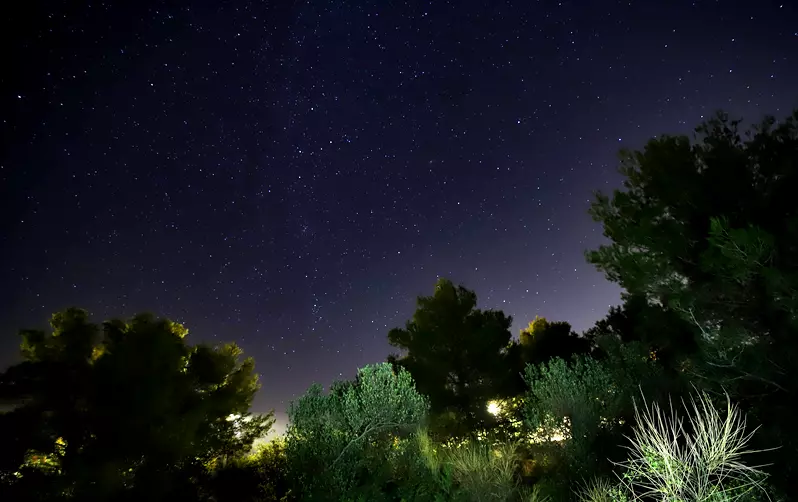
The W of Cassiopeia and the Segment of Perseus, image: Constellation Guide
Ruchbah (Delta Cassiopeiae)
Ruchbah is a white subgiant of the spectral type A5 IV, located 99.4 light years away. With an apparent magnitude of 2.68, it does not appear much fainter than Schedar, Caph and Gamma Cassiopeiae. The star has a mass of 2.49 solar masses and shines with 72.88 solar luminosities from a surface temperature of 7,980 K. It has a radius 3.90 times that of the Sun. Its estimated age is 600 million years.
Delta Cassiopeiae may be an eclipsing binary system of the Algol type. Eclipses have been observed with a period of 759 days, corresponding to the orbital period of the two components.
Segin (Epsilon Cassiopeiae)
Like Gamma Cassiopeiae, Segin is a hot blue star that has evolved quickly and will burn through the rest of its life in the next few million years. Its estimated age is only 15.4 million years.
The star is classified as a blue main sequence star of the spectral type B3 V. It has a mass of 9.2 solar masses and a radius 18.45 times that of the Sun. It is 717.5 times more luminous than the Sun with an effective temperature of 15,174 K. Segin lies 460 light years away and shines at magnitude 3.37. It is classified as a periodic variable.
Constellations near the W
The W pattern can be used to find several less distinctive constellations that lie in the same region. The main asterism of Cepheus (the constellation representing Queen Cassiopeia’s husband) – the House – is found just above the W. An imaginary line extended from Schedar to Caph leads to Alderamin, the brightest star in Cepheus. Alderamin marks the base of the stick house and Errai marks the roof. Both stars take their turn as the North Star over the course of Earth’s precession cycle. The current pole star, Polaris, is the brightest star in the region of the sky on the other side of the roof. Errai will take over as the North Star in about a thousand years.
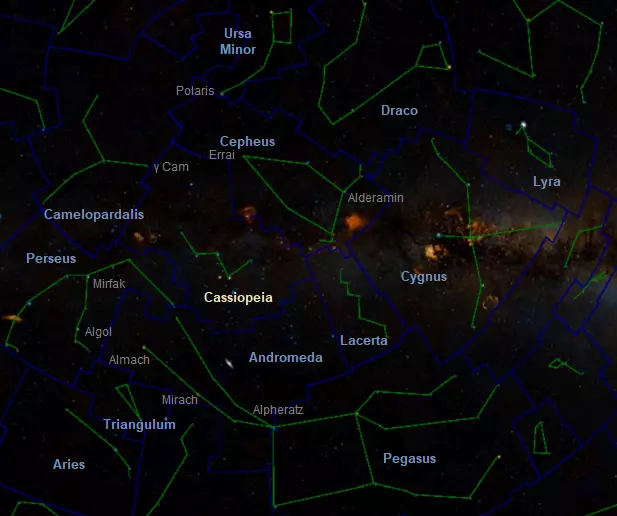
Constellations near Cassiopeia, image: Wikisky
Perseus rises just after Cassiopeia and is easily found by following the imaginary line from Gamma Cassiopeiae through Ruchbah. The line leads to the Double Cluster (NGC 869 and NGC 884), visible as a patch of light when the sky is clear, and then to the Segment of Perseus, a curving line of stars that makes Perseus stand out in this part of the sky. Mirfak, the brightest star in the Segment (and in Perseus), is the central star in the Alpha Persei Cluster, another open cluster visible to the unaided eye. The famous variable star Algol is found below Mirfak.
A line drawn from Gamma Cassiopeiae through Schedar points in the direction of the Square of Pegasus, an asterism that outlines the body of Pegasus. The brightest star in the asterism is Alpheratz, the luminary of the constellation Andromeda. Alpheratz was once part of both Pegasus and Andromeda, but is now assigned only to Andromeda. It is the first in a chain of three bright stars that make Andromeda recognizable. The other two – Mirach and Almach – lie between the Square of Pegasus and Mirfak in Perseus. Mirach is used to find the two brightest and nearest spiral galaxies – the Andromeda Galaxy (M31) and the Triangulum Galaxy (M33).
A line extended from Ruchbah through Segin points towards Gamma Camelopardalis, a magnitude 4.66 white subgiant that is part of the main constellation figure of Camelopardalis, the Giraffe. Even though it is the 18th largest constellation in the sky, Camelopardalis is very faint and its brightest stars are challenging to identify even on a clear night. The constellation occupies much of the space between Cassiopeia and Ursa Major.
Another faint constellation, Lacerta (the Lizard), can be made out between Cassiopeia’s W and Deneb, the star at the top of the Northern Cross in Cygnus. Its zig-zag shape is similar to Cassiopeia’s, which has led to the nickname “Little Cassiopeia.”
Deep sky objects near the W
Cassiopeia’s W serves as a guide for several bright, large deep sky objects that lie in this region of the sky. The famous Heart and Soul Nebulae lie east of Segin, the leftmost star of the W. The two emission nebulae lie 7,500 light years away. The Heart Nebula (IC 1805, Sharpless 2-190) is the larger of the two. It stretches across 150 arcminutes of the apparent sky. It has a physical radius of 165 light years. It is, however, not bright enough for small telescopes, with an apparent magnitude of 18.3.
The Soul Nebula (Westerhout 5, Sharpless 2-199) is associated with several open clusters, including IC 1848, and is often referred to by the cluster designation. It lies at the same distance as the Heart Nebula and stretches across an area of 150 by 75 arcminutes, or about 100 light years. It appears 2.5 degrees southeast of IC 1805.
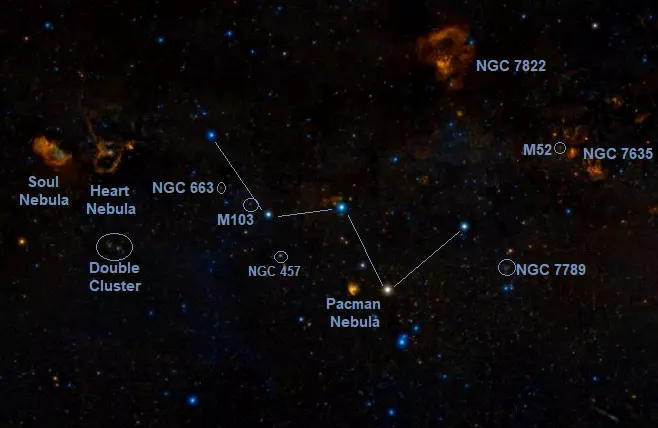
Deep sky objects near Cassiopeia’s W, image: Wikisky
The Double Cluster (NGC 869 and NGC 884) in Perseus is found along the imaginary line extended from Gamma Cassiopeiae through Ruchbah. The two open clusters have apparent magnitudes of 3.7 and 3.8 and are easily visible to the unaided eye. They lie approximately 7.500 light years away and occupy 60 arcminutes of the apparent sky. They are believed to be only 12.8 million years old. Each of the clusters contains more than 300 blue-white supergiants.
The clusters have been known to observers since antiquity. The Greek astrononomer Hipparchus catalogued them in 130 BCE. They appear in the same line of sight as the radiant of the annual Perseid meteor shower, which peaks in mid-August. In depictions of the constellation Perseus, they represent the jewelled handle of the Greek hero’s sword.
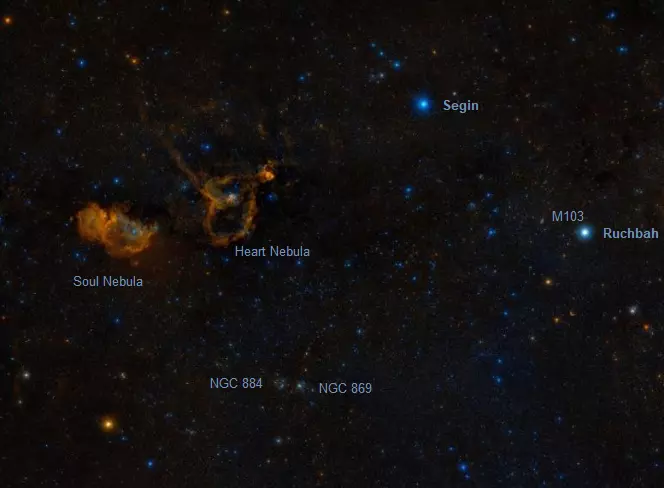
Segin, Ruchbah, the Heart and Soul Nebulae and the Double Cluster, image: Wikisky
Segin can be used to find several fainter open clusters that lie west of the star. These are NGC 637, NGC 609, and NGC 559. NGC 637 lies about 1.5 degrees west-northwest of Segin. It has an apparent magnitude of 8.2 and an apparent size of 4.2 arcminutes. It can be seen in small telescopes. NGC 609 is fainter, with a magnitude of 11, and NGC 559 shines at magnitude 9.5.
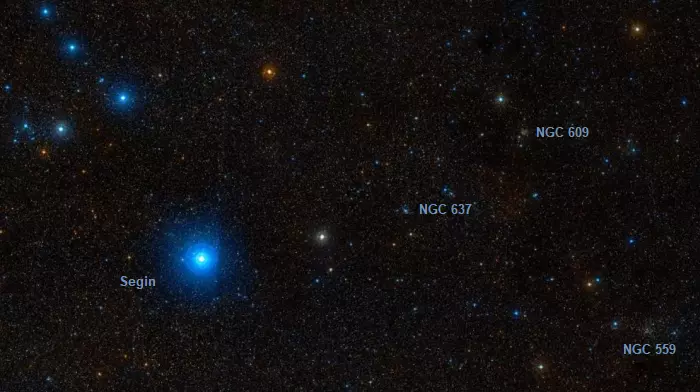
Segin, NGC 637, NGC 609 and NGC 559, image: Wikisky
The region between Segin and Ruchbah makes an excellent target for small telescopes because it contains several bright open clusters. The brightest of these, Messier 103, lies only a degree east of Ruchbah. Also known by the designation NGC 581, the cluster has an apparent magnitude of 7.4 and lies approximately 10,000 light years away. It stretches across 6 arcminutes of the sky. The fainter open cluster Trumpler 1 appears about 40 arcminutes north of M103.
The open cluster NGC 654 lies just east of the line connecting Segin and Ruchbah. With an apparent magnitude of 6.5 and an apparent size of 5 arcminutes, it can be spotted in binoculars. The cluster lies 7,830 light years away. Its estimated age is about 14 million years.
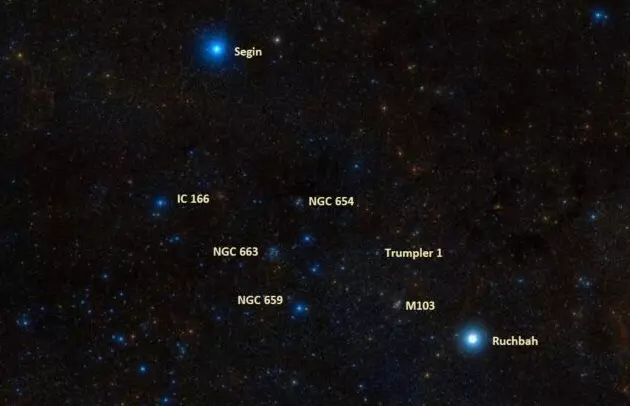
Ruchbah, Segin, Messier 103, NGC 659, Trumpler 1, IC 166, NGC 663 and NGC 654, image: Wikisky
Three other open clusters appear east of the same line: IC 166, NGC 663, and NGC 659. The brightest of these, NGC 633, shines at magnitude 7.1 and has an apparent size of 16 arcminutes. NGC 659 is smaller and fainter, with an apparent size of 6 arcminutes and an apparent magnitude of 7.9. IC 166 is the faintest of the three, shining at magnitude 11.7.
Three interesting deep sky objects can be found in the area south of Ruchbah. The planetary nebula Sharpless 2-188 (Sh2-188) was once thought to be a supernova remnant, but is now known to be a remnant of a less massive star that ejected its outer layers when it reached the end of its life cycle. The nebula is sometimes known as the Dolphin Nebula or the Shrimp Nebula.
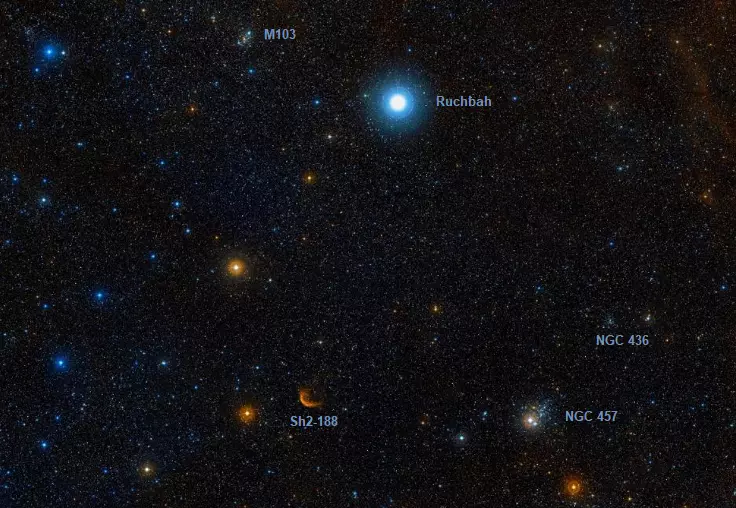
Ruchbah, the Dolphin Nebula (Sh2-188), the E. T. Cluster (NGC 457) and NGC 436, image: Wikisky
Popularly known as the E.T. Cluster or the Owl Cluster, NGC 457 is a young open cluster about 7,900 light years away. With an apparent magnitude of 6.4, it is quite bright and easily visible in binoculars. It has an apparent size of 13 arcminutes. The nearby NGC 436 is fainter, with an apparent magnitude of 8.8.
Gamma Cassiopeiae, the central star of the W, is also surrounded by a few notable deep sky objects. The nebulae IC 59 and IC 63 lie north-northeast of the star and appear in the same field of view. Their clouds are being eroded away by the star’s intense radiation. Due to its peculiar shape, IC 63 is popularly known as the Ghost Nebula, or the Ghost of Cassiopeia. The nebulae have low surface brightness and are difficult objects to spot in a telescope.
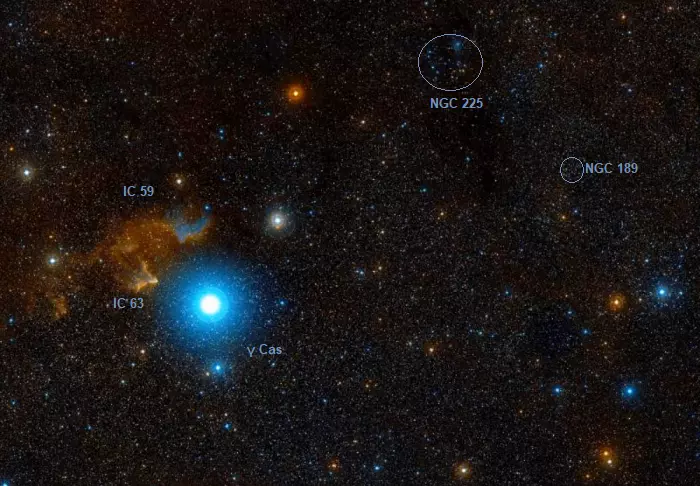
Deep sky objects near Gamma Cassiopeiae, image: Wikisky
NGC 225 is a relatively bright open cluster northwest of Gamma Cassiopeiae. Nicknamed the Sailboat Cluster, it has an apparent size of 12 arcminutes and shines at magnitude 7.0 from a distance of 2,143 light years. Its fainter neighbour NGC 189 (mag. 8.8) is more distant at 4,200 light years.
Schedar, the bottom right star of the W, is a guide to the Pacman Nebula, a large emission nebula also known by the designations NGC 281, IC 11, and Sh2-184. Named for its resemblance to the popular video game character, the nebula is 35 arcminutes across and lies approximately 9,500 light years away. It forms a triangle with Schedar and the magnitude 3.44 star Achird (Eta Cassiopeiae).
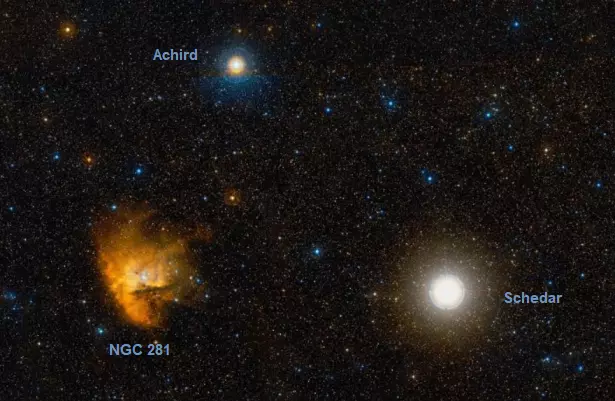
Schedar, Achird and the Pacman Nebula (NGC 281), image: Wikisky
Caph can be used to find the irregular galaxy IC 10. The galaxy has an apparent magnitude of 10.4 and lies 2.5 million light years away. It is a member of the Local Group, which also includes the Milky Way and Andromeda. The galaxy appears east of Caph.
The open cluster NGC 7789 is found east of Schedar and southeast of Caph. It is quite bright and large, with an apparent magnitude of 6.7 and an apparent size of 16 arcminutes. It is also known as the White Rose Cluster or Caroline’s Rose. It was discovered by the German astronomer Caroline Herschel in 1783.
A pair of open clusters, NGC 7788 and NGC 7790 can be spotted northeast of Caph. NGC 7788 has an apparent magnitude of 9.40 and lies 7,700 light years away, while NGC 7790 shines at magnitude 8.5 from a distance of 10,760 light years.
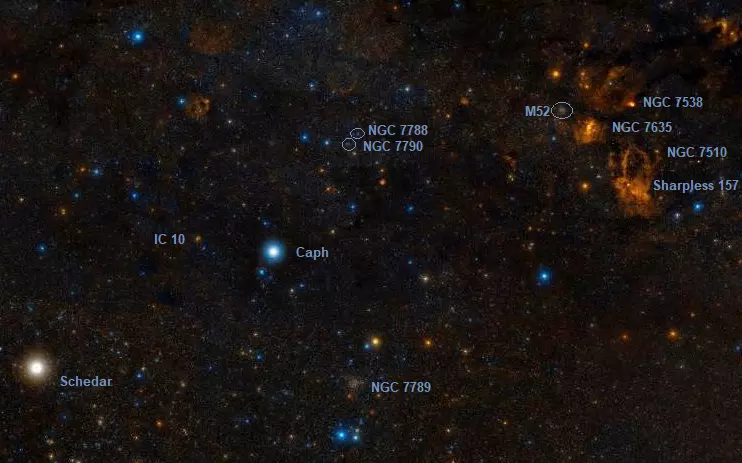
Caph, Schedar, Messier 52, NGC 7635, NGC 7538, NGC 7510, NGC 7790, NGC 7788 and NGC 7789, image: Wikisky
Schedar and Caph can be used to find a grouping of bright deep sky objects on the border between Cassiopeia and Cepheus. A line drawn from Schedar through Caph and extended by about the same distance as that between the two stars leads to Messier 52, a magnitude 6.9 open cluster in Cassiopeia. The cluster has a mass of 1,200 Suns and lies 4,600 light years away. It has an apparent size of 13 arcminutes, which corresponds to a linear radius of 9.5 light years. The estimated age of M52 is 158.5 million years.
The Bubble Nebula (NGC 7635) lies only about 35 arcminutes southwest of M52 and can be seen in the same field of view. The emission nebula is not related to the cluster since it lies much farther away. Distance estimates range from 7,100 to 11,000 light years. The nebula has an apparent magnitude of 10 and an apparent size of 15 by 8 arcminutes. It can be seen in 8-inch and larger telescopes.
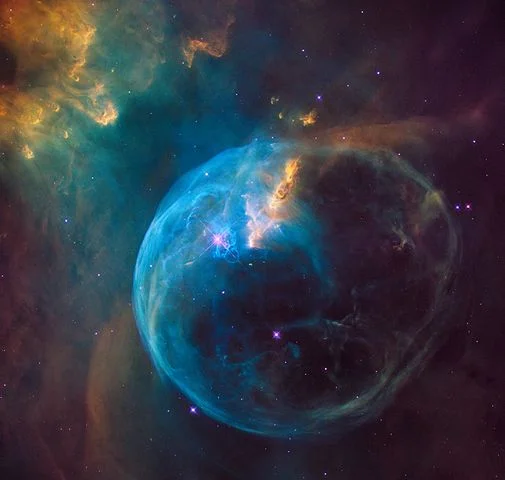
For the 26th birthday of NASA’s Hubble Space Telescope, astronomers are highlighting a Hubble image of an enormous bubble being blown into space by a super-hot, massive star. The Hubble image of the Bubble Nebula, or NGC 7635, was chosen to mark the 26th anniversary of the launch of Hubble into Earth orbit by the STS-31 space shuttle crew on April 24, 1990. Image: NASA, ESA, and the Hubble Heritage Team (STScI/AURA)
The nebula NGC 7538 appears east of M52 and lies 9,100 light years away in Cepheus. It is notable for containing the largest protostar discovered to date, about 300 times larger than the solar system. The open cluster NGC 7510 (mag. 7.9) is found to the southeast.
The Lobster Claw Nebula (Sharpless 157), a bright emission nebula, can be seen just south of the Bubble Nebula. It lies 11,050 light years away.
The stars and deep sky objects in Cassiopeia can be seen year-round from the northern hemisphere. The best time of year to observe them is during the months of autumn, when the constellation rises in the evening and makes its way across the sky throughout the night.